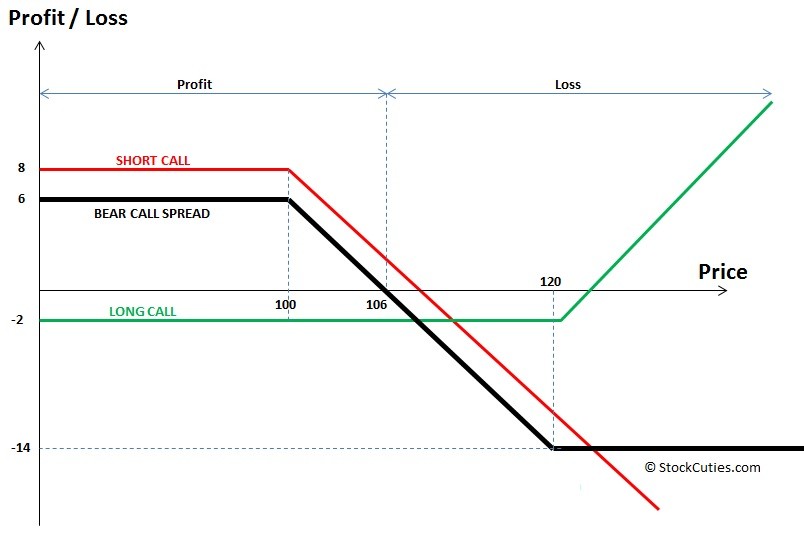Call Spreads by
Post on: 8 Апрель, 2015 No Comment

Call Spreads Day — Definition
Call Spreads are options strategies constructed using call options only.
Call Spreads — Introduction
Call spreads are amongst the most common options trading strategies in the world today. As the name suggests, Call Spreads are a group of options strategies consisting of buying and writing two or more different call options in order to achieve specific payoff profiles. Even though Call Spreads are made up of only call options, call spreads are capable of profiting not only when the price of the underlying stock goes upwards but there are also call spreads that profit when the underlying stock goes sideways or downwards.
This tutorial shall introduce the different types of popular call spreads and explore the logic and mechanism behind call spreads in options trading.
What are Call Spreads?
Why Use Call Spreads Instead of Just Call Options?
So, why use call spreads instead of simply buying or writing call options since doing so also allows you to cover all three directions? The main reason why call spreads are used by options veterans instead of just simple call options buying or writing is for the purpose of hedging. The result of this kind of hedging modifies the risk graph of the position and when expertly calculated, can result in a payoff characteristic that perfectly suit your outlook on the movement of the underlying stock.
The most basic call spreads typically writes an additional call option on call options bought or buys an additional call option on call options written. Doing so partially hedges against capital risk by lowering the cost or margin of the position and hedges away the unlimited loss potential of a short call options position. In fact, there are call spreads that so completely hedges against downside risk that a call options position can be designed not only to profit when the underlying stock goes up but also to make a small profit when the underlying stock goes down!
Classification of Call Spreads
Call spreads can be broadly classified as Vertical Call Spreads, Horizontal Call Spreads or Diagonal Call Spreads in options trading, based on the relative moneyness and expiration date of the call options used in the position.
Vertical Call Spreads are call spreads that consist of call options of the same expiration month but different strike prices. Vertical Call Spreads include the most popular Bull Call spread as well as more complex strategies such as the Call Butterfly Spread.
Horizontal Call Spreads are call spreads that consist of call options of the same strike price but different expiration months. Horizontal Call Spreads are usually Call Calendar Spreads or Call Time Spreads.
Diagonal Call Spreads are call spreads that consist of call options of different strike price and expiration months. Diagonal Call Spreads include Diagonal Call Calendar Spreads.
Of course it isn’t important or necessary to know these classifications in order to trade call options so options trading beginners need not put too much emphasis on this part.
List of Popular Call Spreads
Here is a list of the most popular and most commonly used Call Spreads in options trading:
Bull Call Spread : A Bullish Call Spread consisting of buying at the money call options and writing out of the money call options in order to lower cost.
Bear Call Spread : A Bearish Call Spread consisting of writing at the money call options and buying out of the money call options in order to lower margin requirement and hedge against unlimited risk.
Ratio Bull Spread : A call spread that makes a small profit when the stock goes downwards and achieves its maximum profit when the stock goes upwards to a certain price limit.
Call Butterfly Spread : A complex neutral call spread consisting of writing at the money call options and buying in the money and out of the money call options against it.
Call Condor Spread : A complex neutral call spread similiar to the Call Butterfly Spread but writing slightly in the money and slightly out of the money call options instead of at the money call options.
Call Time Spread : A complex neutral call spread consisting of buying long term call options and writing short term call options against it.
Call Ratio Backspread : A complex volatile call spread consisting of buying at the money or out of the money call options and writing in the money call options against it.
Advantages of Call Spreads
As you can see above, there are call spreads for every market outlook; Bullish, Bearish, Neutral or Volatile. This is some which merely buying or writing call options individually cannot achieve. By putting together long and short call options of different options moneyness or expiration. the risk profile of a call options position can be modified or designed to reach maximum profitability at specific prices and keep maximum loss within a pre-determinable limit.
Disadvantages of Call Spreads
The main disadvantage of call spreads is the additional commissions incurred by the additional legs involved in each position. Call spreads that limit maximum potential profit could also cause you to make lesser than you should have if you have simply bought call options instead if the underlying stock should rally strongly. The other disadvantage of call spreads is that short legs need to be held all the way to expiration for their full value to be realised. If a position is closed early, the short legs could in fact appreciate, causing you to buy back the short legs at a higher price, reducing your profits and incurring additional commissions. As such, if you are trading an extremely short move, you should consider using call options that are very near expiration or not use call spreads at all.














